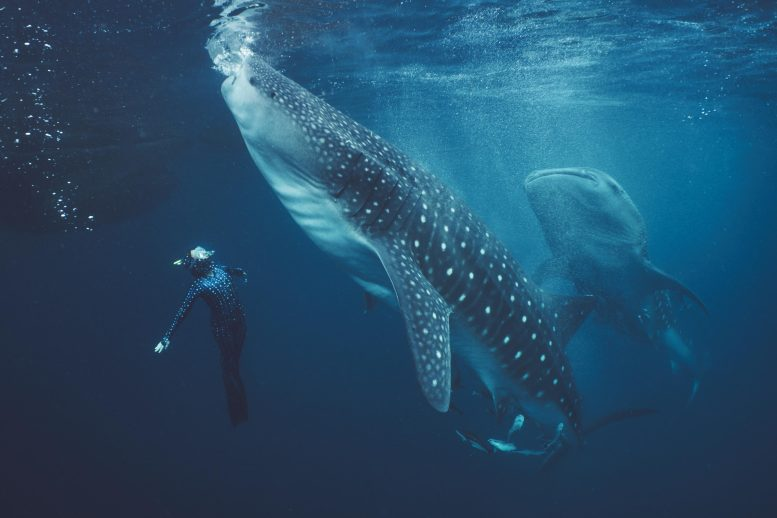Whale Sharks in Indonesia Are Covered in Scars, and Humans Are the Main Cause

Whale sharks are the largest fish in the ocean, gentle giants that glide through tropical waters feeding on plankton and small fish.
Despite their calm presence and ecological importance, these animals are facing a serious problem in parts of Indonesia. A new study has revealed that over 60% of whale sharks in the Bird’s Head Seascape of West Papua carry visible scars and injuries, most of them linked to human activities such as boat strikes and traditional fishing platforms known as bagans.
This article breaks down all the details of the study, the statistics gathered, and what scientists believe can be done to prevent further harm. Along the way, you’ll also find some extra background information about whale sharks themselves—their biology, threats, and role in marine ecosystems.
The Study Location and Duration
The research was conducted in the Bird’s Head Seascape (BHS), a massive marine region in eastern Indonesia that includes Cenderawasih Bay, Kaimana, Raja Ampat, and Fakfak. This region is recognized as a hotspot of marine biodiversity and is home to 26 marine protected areas, making it one of the most critical conservation zones in the Indo-Pacific.
The study took place over a long period—from September 2010 to October 2023—spanning 13 years of data collection. This long timeline allowed scientists to build a comprehensive picture of whale shark presence, injuries, and behaviors across the region.
Methods Used to Study Whale Sharks
The team used a method called photo-identification. Each whale shark has a unique pattern of white spots and stripes, much like human fingerprints, which can be used to identify individuals. By analyzing photographs taken during surveys and contributions from citizen scientists, the researchers were able to track the presence, movement, and condition of individual sharks.
For every sighting, the following data was recorded:
- Date and time
- GPS coordinates
- Size and sex of the shark
- Maturity status (juvenile or adult)
- Behavior observed
- Visible injuries or scars
Citizen science platforms such as Wildbook for Sharks also provided valuable photographic data, boosting the coverage and accuracy of the study.
Whale Shark Sightings and Numbers
Between 2010 and 2023, researchers logged 1,118 confirmed sightings, which corresponded to 268 unique whale sharks. Out of these sightings:
- 97.8% occurred in Cenderawasih Bay and Kaimana
- Sightings were recorded across 327 distinct locations
- Around 314 of those sites were associated with bagans, where whale sharks often gathered to feed
This heavy concentration around bagans is important, because it shows how closely whale sharks are tied to areas where humans are also active.
Residency and Re-Sightings
Over half of the whale sharks identified—52.6%—were seen more than once during the study period. Some individuals were recorded up to 11 years apart, showing strong site fidelity.
One young male whale shark became a record-holder, being sighted 34 times over three years at bagans in Kaimana. Despite their wide-ranging abilities, the study found very little movement across different regions within the Bird’s Head Seascape. Only two individual sharks were ever observed moving between subregions. This suggests that many whale sharks prefer to stick to localized areas, which makes them particularly vulnerable to repeated human interactions.
Demographics: Who Were These Sharks?
The sex of 235 sharks could be confirmed. The results showed a heavily male-biased population:
- 89.8% were males
- Only 10.2% were females
The sex ratio was roughly 8.8 males for every female.
In terms of size, most sharks measured 4–5 meters long, placing them in the juvenile category. This further suggests that Bird’s Head Seascape serves as an important nursery habitat for young whale sharks. Adult females and older individuals are believed to prefer deeper offshore environments like seamounts and canyons, which aligns with global observations of the species.
Scars and Injuries: The Core Finding
Of the 268 whale sharks observed, 206 individuals showed scars or injuries. Breaking it down further:
- 80.6% of these injuries were caused by human activities
- 58.3% were attributed to natural causes (some sharks had both types)
The most frequent injuries were minor abrasions and fin nicks. These are often caused when whale sharks brush against the wooden beams or net frames of bagans, or when they rub against the hulls of boats.
However, more severe injuries were also present:
- 17.7% of scarred individuals showed major wounds such as deep lacerations, amputations, or blunt trauma, many of which were linked to boat propellers or heavy collisions.
While minor injuries may not be life-threatening, they indicate persistent, preventable harm from ongoing human contact.
Whale Shark Feeding Behavior Around Bagans
The research team documented three main feeding behaviors:
- Horizontal feeding – swimming with an open mouth through schools of baitfish.
- Vertical feeding – hanging upright and gulping prey at the surface.
- Suction feeding – directly sucking fish from bagan nets, often damaging the nets in the process.
Whale sharks were typically seen feeding on small fish such as anchovies, herrings, and sprats. Their presence at bagans is directly tied to the abundance of these baitfish, which are attracted by the fishing platforms themselves.
Seasonal and Daily Patterns
The researchers noticed seasonal variations in sightings:
- In Kaimana, whale shark presence peaked between February–April and November–December.
- In Cenderawasih Bay, sightings were more evenly spread across the year, likely due to its sheltered location.
Time of day also mattered:
- Most sightings occurred between 6 am and 10 am.
- Peak activity times differed slightly by location: around 7 am in Cenderawasih Bay and 8 am in Kaimana.
These patterns reflect both whale shark behavior and the timing of human fishing activities.
Why Are Females and Adults Rare Here?
The absence of mature females and older individuals puzzled researchers at first. However, other studies around the world have shown similar patterns. Adult females and large adults often stay in deep-ocean environments, where they feed on prey like krill and large schools of fish. Juvenile males, on the other hand, prefer coastal waters with abundant plankton and baitfish, which help them grow quickly.
This explains why Bird’s Head Seascape is dominated by juvenile males—it is essentially a developmental habitat rather than a breeding ground.
Tourism and Its Risks
Whale shark tourism is growing in popularity in Cenderawasih Bay and Kaimana. Since the sharks show high residency and are often resighted, they represent a valuable economic asset for local communities. However, this popularity also raises risks.
When boats and tourists crowd around feeding sharks, the chance of injury increases. In some cases, operators may even feed sharks deliberately to keep them at the surface, which further raises the risk of boat collisions and entanglement.
Proposed Solutions to Reduce Harm
The researchers suggest practical interventions that could dramatically reduce the number of scars:
- Modify bagans by removing sharp edges from net frames and boat outriggers.
- Work with marine protected area authorities to enforce regulations on safe tourism practices.
- Encourage proper boat handling, such as slower speeds and maintaining a safe distance when sharks are present.
- Continue citizen science involvement to help with long-term monitoring.
These changes are described as simple, low-cost, and highly effective. With such measures, the number of injuries could be reduced substantially.
Broader Background: Whale Sharks at a Global Level
Whale sharks (Rhincodon typus) are listed as Endangered on the IUCN Red List. Global populations have dropped by more than 50% in the past 75 years, with declines of up to 63% in the Indo-Pacific region.
Their biology makes recovery difficult:
- Whale sharks take up to 30 years to reach sexual maturity.
- Females give birth to live young, but reproduction rates are very low.
- As slow-growing animals, populations cannot quickly bounce back from threats.
Global threats include:
- Commercial hunting (historically for fins, meat, and oil)
- Bycatch in tuna fisheries
- Collisions with ships
- Habitat degradation
- Unregulated tourism
Despite these challenges, whale sharks play an important ecological role as filter feeders, helping maintain the balance of plankton populations in tropical seas.
Why This Study Matters
The Bird’s Head Seascape study adds critical detail to our understanding of whale shark populations in Indonesia:
- It shows that juvenile males dominate the area.
- It documents the high level of preventable scarring caused by humans.
- It highlights how bagans act as focal points for both feeding and danger.
- It stresses that small changes in fishing and tourism practices can make a big difference.
Protecting whale sharks is not only about saving an endangered species but also about preserving cultural and economic value for local communities that rely on marine tourism.





